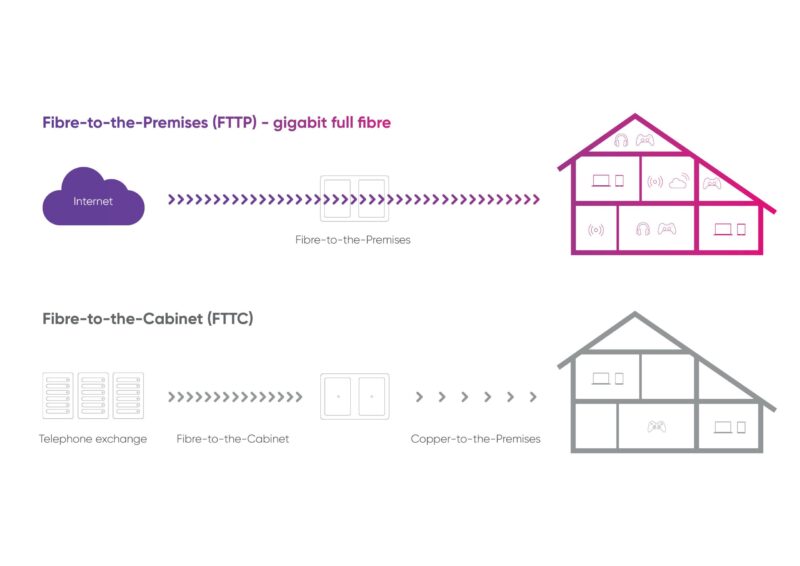When picking out a broadband provider or connection, you will often come across jargon that means nothing to you. ‘Fibre’, ‘superfast’, ‘ultrafast’ these all sound impressive but what does it all really mean? To make sure you are receiving the most reliable, powerful connection, a Fibre-to-the-Premises or FTTP connection is what you need to be looking for, this will often fall under the ‘ultrafast’ title.
Does super reliable broadband really matter when your current connection isn’t ‘that’ bad? Well, yes and especially now. The average household is connecting more web-enabled devices than ever before and this number is only set to increase. Add to this the boom in home-based cloud working and you have a recipe for disaster unless you have enough bandwidth and reliable connectivity.
Some confusing broadband terms explained:
Broadband? An internet connection, distinct from the old dial-up internet.
Bandwidth? The capacity of a connection. E.g. high-definition video streaming uses a lot of bandwidth.
Basic broadband? Up to 30Mbps service that comes from high-speed cable, satellite and wireless connections (ADSL). To download a 2-hour HD film it would take 1 hour and 47 minutes.
Superfast broadband? Above 24Mbps, this is the general definition of superfast, and most often refers to a Fibre-to-the-Cabinet (FTTC) connection. Superfast connections are available to 96% of homes in the UK. Most of the popular Internet Service Providers offer deals with average speeds ranging from 30Mbps to 300 Mbps. These are all superfast. To download a 2-hour HD film would take 37 minutes and 30 seconds.
Mbps? Short for megabits per second, a measure of data transfer speed (a megabit is equal to one million bits) for broadband. The higher the number, the faster the speed.
FTTC (part fibre)? Fibre-to-the-Cabinet: the fibre-optic cabling is laid to the cabinets, then uses century old copper phone lines to provide a broadband connection to the home. This is the most common type of fibre broadband advertised, limiting speeds to 24Mbps.
Ask yourself this, do you often experience lag, buffering or down time? If your answer is yes, it’s likely you are receiving a fibre-to-the-cabinet broadband connection only.
FTTP/FTTH (Full Fibre)? Fibre-to-the-Premises/Fibre-to-the-Home: the cabling is laid to the cabinets, and then extended from the cabinet directly into the home. This allows ultrafast speeds of 1,000Mbps (1Gbps). However, in the future this technology will allow for even faster speeds.
Whilst the switch to full fibre has been taking place across the world for many years, the UK is still playing catch-up.
Gbps? Short for gigabits per second, often denotes a measure for ultrafast broadband and data transfer (a gigabit is equal to one thousand Mbps). An example of this is LilaConnect full fibre.
Fibre optic broadband? A method of transferring data using pulses of light sent along very fine glass fibre. Fibre optic data communications are fast, less prone to interference and deliver the same speed to users regardless of distance from the cabinet (this only applies to full fibre).
Ultrafast broadband? There are varying definitions for Ultrafast Broadband. Delivered by Fibre-to-the-Home (FTTH), the UK Government defines Ultrafast as broadband that is 100Mbps or faster however this is now slightly outdated and we would now define Ultrafast as speeds of more than 300Mbps. To download a 2-hour HD film it would take 53 seconds.
Gigabit services? Broadband service capable of achieving connections of 1Gbps or higher.
Wi-Fi? A facility allowing computers, smartphones, or other devices to connect wirelessly to the internet within a particular area. Note: your Wi-Fi speed will not be the same as your broadband speed.
Download speed? The rate at which data is sent from the internet to your computer. E.g. streaming music or TV programmes.
Upload speed? The rate at which data is sent from your computer to the internet. E.g. sharing images or video.
Router? Manages the local network traffic, sending information between connected computers. It may also direct traffic to a hard drive or printer. This is the box in your house where the internet password is generally printed or attached. You will receive a router from your chosen Internet Service Provider.
LilaConnect’s Fibre-to-the-Premises (FTTP) gigabit full fibre technology will provide your home or business with enough bandwidth to cope with the demands of any number of devices, all at the same time. And with our symmetric full fibre, that speed goes both ways, meaning that the lightning-fast speed of your uploads now matches your downloads … that’s stable, lightning-fast connections with no lag, buffering or down time. We do this by installing next generation point-to-point fibre optic cabling all the way into your home or business, no sharing!
If you’re interested to know more, why not find out when we we’re coming to your area? Register your interest here for more information.


